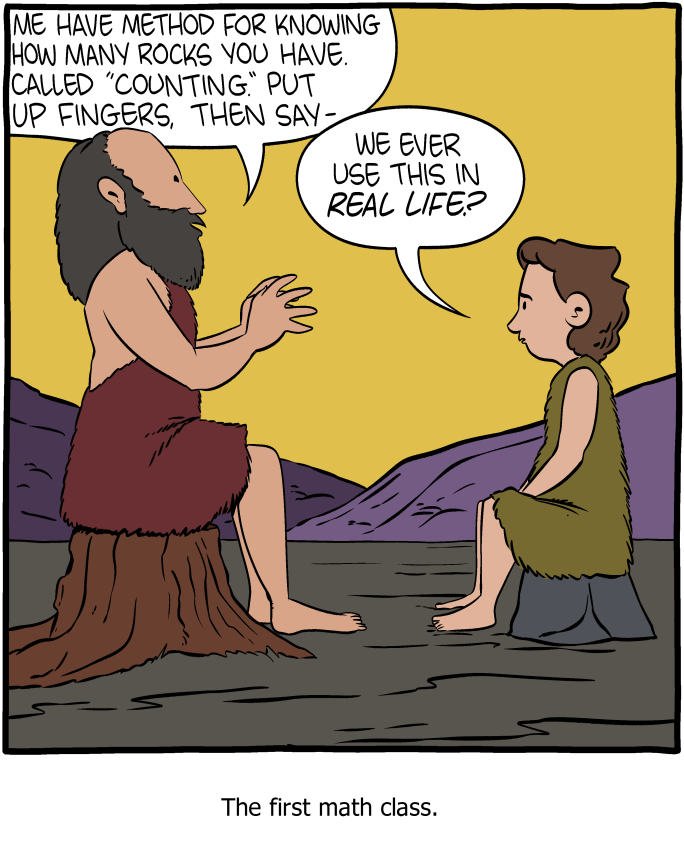Real life
« previous post | next post »
Today's SMBC:
For a more complex but pointed analogy, see "The Pirahã and us", 10/6/2007.
July 24, 2017 @ 9:51 am · Filed by Mark Liberman under Linguistics in the comics
« previous post | next post »
Today's SMBC:
For a more complex but pointed analogy, see "The Pirahã and us", 10/6/2007.
July 24, 2017 @ 9:51 am · Filed by Mark Liberman under Linguistics in the comics
Powered By WordPress

Cervantes said,
July 24, 2017 @ 10:07 am
Actually, a lot of academic investigators who use Gaussian statistics, and the peer reviewers and editors who read and publish their manuscripts, don't understand it either. More than once I've gotten papers to review in which an effect is p > .05 in group A and P < .05 in group B, and the conclusion is that A and B are different in their response to the IV. That's just for starters.
[(myl) Indeed. One of the most important confusions is the difference between "(statistically) significant" and "significant in practical (or clinical or social) terms". For some discussion, see "'Significance' in 1885 and today", 5/17/2013, and the links therein.]
Sean M said,
July 24, 2017 @ 12:20 pm
Cervantes, that sounds like exactly the point of "The Pirahã and us": even amongst people whom our society trains and employs as experts in reasoning statistically about a particular topic, many struggle to do more than follow rules of thumb. I would say that significantly more than "50,000" people are employed to teach or research in the quantitative social sciences in the United States, after all.
[(myl) I wonder whether "significantly more than 50,000" is accurate — the American Economic Association has 18,000 members and the American Sociological Association has 14,000.
Anyhow, even if the number of distribution-talk understanders in the U.S. today were 500,000 (which I suspect is a large overestimate), that would project onto the population of the Pirahã as
50000/323000000 = x/300
x = 300*500000/323000000 = 0.46
]
Cervantes said,
July 24, 2017 @ 12:30 pm
Something strange happened to my post. It should read "p is greater than .05 in Group A and p is less than .05 in Group B." That's what I wrote, but the cybergods apparently interpreted the greater than and less than signs as parts of HTML tags.
[(myl) Fixed now. Obviously you know about > and < for the "greater than" and "less than" symbols; now you know (or have been reminded) that WordPress comments think that the input is in a restricted sort of html, in which the bare lt and gt symbols are interpreted as the start and end of tags…]
Not only do people not know the difference between statistical and practical significance, they don't know what statistical significance means either. That's how we get p hacking and claims that A and B are not associated because p is just above .05 in your small study. And a whole lot more howlers. John Ioannidis is on the case but he's trying to sweep the beach.
Cervantes said,
July 24, 2017 @ 1:27 pm
Yeah, I did know about it but it's been a long time since I needed the knowledge and it didn't pull up on this occasion. Thanks.
Paul Garrett said,
July 24, 2017 @ 6:05 pm
As a mathematician, having taught at universities in the U.S. for the last 40+ years, I can aver that many quite intelligent people find no interest in mathematics or statistics. As with the Piraha (sorry, lost the diacritical mark), most people, and their friends, simply do not engage with mathematics or statistics… even if, arguably, they'd benefit from it. Public communications involving numbers or correlations (or causation…) are invariably almost completely ignorant. Yet only a tiny, tiny fraction of people are put off by this, apparently.
(Cf., "In the Country of the Blind".)
rwmg said,
July 24, 2017 @ 8:39 pm
The situation is far worse than you suppose. I am continually surprised by the number of people who look at me as if I was practising the deepest, darkest magic when I use a calculator to multiply by .65 to work out 65% of something rather than use the % key.
wtsparrow said,
July 25, 2017 @ 1:03 pm
Isn't it more likely that the cave men would speak grammatical Caveman rather than the broken Caveman implied by the broken English in the cartoon?
Jerry Friedman said,
July 25, 2017 @ 3:11 pm
wtsparrow: Yes. It's a conventional sign of cavemanity, like having the prison-camp guards speak English with German accents when they'd really be speaking German.
I suspect cavemen didn't have flat stumps to sit on, trim their beards, or wear animal skins so neatly either.
Makkte said,
July 25, 2017 @ 5:02 pm
The full stops/periods in the cartoon are too small and faint to be immediately noticeable to my middle-aged eyes, leading me to take several tries at reading it. Also, the text uses the US convention of placing a period inside a terminal speech mark, so it was functionally invisible to me as well as practically so. When I finally managed to read the cartoon, I was satisfied.